Root System Analysis and Influence of Moisture on Soil Electrical Properties
Abstract
:1. Introduction
2. Theoretical Background
2.1. Moisture and Soil Compaction
2.2. Soil Stratification Method
2.3. Lateral Profiling Method
2.4. Root System
3. Methodology
3.1. Relationship between Moisture × Electrical Conductivity of the Soil
3.2. Relationship between Root System × Soil Electrical Conductivity
4. Results
4.1. Results of the Relationship between Soil Electrical Conductivity × Moisture
Soil Stratification in Horizontal Layers
4.2. Results of Soil Electrical Conductivity × Root System
4.3. Root System Mapping in the Field
5. Discussion
6. Conclusions
Author Contributions
Funding
Institutional Review Board Statement
Informed Consent Statement
Data Availability Statement
Acknowledgments
Conflicts of Interest
Abbreviations
| apparent electrical conductivity of the soil | |
| root system | |
| soil moisture content | |
| TDR | Time Domain Reflectometry |
| C | soil compaction |
| apparent electrical resistance | |
| apparent electrical resistivity of the soil | |
| a | spacing between rods in Wenner array |
| i | summation variable |
| thickness of the first soil layer | |
| thickness of the second soil layer | |
| thickness of the third soil layer | |
| P | rods depth in Wenner array |
| K | reflection coefficient of the expression of soil stratification in two layers |
| apparent resistivity of the first soil layer | |
| apparent resistivity of the second soil layer | |
| apparent resistivity of the third soil layer | |
| apparent resistivity of the fourth soil layer | |
| MSP | moisture saturation point |
| N | number of layers |
| PVC | polyvinyl chloride |
| HDPE | high-density polyethylene |
| average temperature data of the highs | |
| average temperature data of the lows | |
| total precipitation |
References
- Telford, W.M.; Geldart, L.P.; Sheriff, R.E. Applied Geophysics; Cambridge University Press: Cambridge, UK, 1990. [Google Scholar]
- Corwin, D.L.; Lesch, S.M. Apparent soil electrical conductivity measurements in agriculture. Comput. Electron. Agric. 2005, 46, 11–43. [Google Scholar] [CrossRef]
- Silva Filho, A.M.; Silva, C.L.B.; Oliveira, M.A.A.; Pires, T.G.; Alves, A.J.; Narciso, M.G.; Calixto, W.P. Geoelectric method applied in correlation between physical characteristics and electrical properties of the soil. Trans. Environ. Electr. Eng. 2017, 2, 36. [Google Scholar] [CrossRef]
- Moral, F.J.; Terrón, J.M.; Marques da Silva, J.R. Delineation of management zones using mobile measurements of soil apparent electrical conductivity and multivariate geostatistical techniques. Soil Tillage Res. 2005, 106, 335–343. [Google Scholar] [CrossRef]
- Johnson, C.K.; Doran, J.W.; Duke, H.R.; Wienhold, B.J.; Eskridge, K.M.; Shanahan, J.F. Field-scale electrical conductivity mapping for delineating soil condition. Soil Sci. Soc. Am. J. 2001, 65, 1829–1837. [Google Scholar] [CrossRef] [Green Version]
- Serrano, J.M.; Shahidian, S.; Da Silva, J.M. Spatial variability and temporal stability of apparent soil electrical conductivity in a Mediterranean pasture. Precis. Agric. 2017, 18, 245–263. [Google Scholar] [CrossRef]
- Sanches, G.M.; Magalhães, P.S.G.; Remacre, A.Z.; Franco, H.C.J. Potential of apparent soil electrical conductivity to describe the soil pH and improve lime application in a clayey soil. Soil Tillage Res. 2018, 175, 217–225. [Google Scholar] [CrossRef]
- Li, H.Y.; Shi, Z.; Webster, R.; Triantafilis, J. Mapping the three-dimensional variation of soil salinity in a rice-paddy soil. Geoderma 2005, 195–196, 31–41. [Google Scholar] [CrossRef]
- Corwin, D.L.; Lesch, S.M.; Shouse, P.J.; Soppe, R.; Ayars, J.E. Identifying Soil Properties that Influence Cotton Yield Using Soil Sampling Directed by Apparent Soil Electrical Conductivity. Agron. J. 2003, 95, 352–364. [Google Scholar] [CrossRef] [Green Version]
- Cillis, D.; Pezzuolo, A.; Marinello, F.; Sartori, L. Field-scale electrical resistivity profiling mapping for delineating soil condition in a nitrate vulnerable zone. Appl. Soil Ecol. 2018, 123, 780–786. [Google Scholar] [CrossRef]
- Cimpoiaşu, M.O.; Kuras, O.; Pridmore, T.; Mooney, S.J. Potential of geoelectrical methods to monitor root zone processes and structure: A review. Geoderma 2020, 365, 114232. [Google Scholar] [CrossRef]
- Amato, M.; Basso, B.; Celano, G.; Bitella, G.; Morelli, G.; Rossi, R. In situ detection of tree root distribution and biomass by multi-electrode resistivity imaging. Tree Physiol. 2008, 28, 1441–1448. [Google Scholar] [CrossRef]
- Zhao, P.-F.; Wang, Y.-Q.; Yan, S.-X.; Fan, L.-F.; Wang, Z.-Y.; Zhou, Q.; Yao, J.-P.; Cheng, Q.; Wang, Z.-Y.; Huang, L. Electrical imaging of plant root zone: A review. Comput. Electron. Agric. 2019, 167, 105058. [Google Scholar] [CrossRef]
- Paglis, C.M. Application of Electrical Resistivity Tomography for Detecting Root Biomass in Coffee Trees. Int. J. Geophys. 2013. [Google Scholar] [CrossRef]
- Loperte, A.; Satriani, A.; Lazzari, L.; Amato, M.; Celano, G.; Lapenna, V.; Morelli, G. 2D and 3D high resolution geoelectrical tomography for non-destructive determination of the spatial variability of plant root distribution: Laboratory experiments and field measurements. Geophys. Res. Abstr. 2006, 8, 674. [Google Scholar]
- Head, K.H. Manual of Soil Laboratory Testin. In Soil Classification and Compaction Tests; Whittles Publishing: Scotland, UK, 2006; Volume 1. [Google Scholar]
- Soane, B.D.; van Ouwerkerk, C. Soil Compaction in Crop Production; Elsevier: Amsterdam, The Netherlands, 2013. [Google Scholar]
- Naderi-Boldaji, M.; Sharifi, A.; Hemmat, A.; Alimardani, R.; Keller, T. Feasibility study on the potential of electrical conductivity sensor Veris® 3100 for field mapping of topsoil strength. Biosyst. Eng. 2014, 126, 1–11. [Google Scholar] [CrossRef]
- Roodposhti, H.R.; Hafizi, M.K.; Kermani, M.R.S.; Nik, M.R.G. Electrical resistivity method for water content and compaction evaluation, a laboratory test on construction material. J. Appl. Geophys. 2019, 168, 49–58. [Google Scholar] [CrossRef]
- Friedman, S.P. Soil properties influencing apparent electrical conductivity: A review. Comput. Electron. Agric. 2005, 46, 45–70. [Google Scholar] [CrossRef]
- Corwin, D.L.; Lesch, S.M. Application of Soil Electrical Conductivity to Precision Agriculture. Agron. J. 2003, 95, 455–471. [Google Scholar]
- Corwin, D.L.; Lesch, S.M.; Oster, J.D.; Kaffka, S.R. Monitoring management-induced spatio–temporal changes in soil quality through soil sampling directed by apparent electrical conductivity. Geoderma 2006, 131, 369–387. [Google Scholar] [CrossRef]
- Wenner, F.A. Method of Measuring Earth Resistivity; Bulletin of National Bureau of Standards: Washington, DC, USA, 1916; Volume 12. [Google Scholar]
- IEEE Std 142 Recommended Practice for Grounding of Industrial and Commercial Power Systems. Available online: https://hibp.ecse.rpi.edu/connor/education/Fields/IEEEStd142_2007.pdf (accessed on 16 October 2021).
- Pirson, S.J. Geologic Well Log Analysis; Gulf Publishing Co.: Houston, TX, USA, 1963. [Google Scholar]
- Sudduth, K.A.; Myers, D.B.; Kitchen, N.R.; Drummond, S.T. Modeling soil electrical conductivity–depth relationships with data from proximal and penetrating ECa sensors. Geoderma 2013, 199, 12–21. [Google Scholar] [CrossRef]
- Banton, O.; Seguin, M.K.; Cimon, M.A. Mapping Field-Scale Physical Properties of Soil with Electrical Resistivity. Soil Sci. Soc. Am. J. 1997, 61, 1010–1017. [Google Scholar] [CrossRef]
- Hagrey, A. Numerical and experimental mapping of small root zones using optimized surface and borehole resistivity tomography. Geophysics 2011, 76, G25–G35. [Google Scholar] [CrossRef]
- Bohm, W. Methods of Studying Root Systems; Springer: New York, NY, USA, 1979. [Google Scholar]
- Melo, L.B.B.; Silva, B.M.; Peixoto, D.S.; Chiarini, T.P.A.; Oliveira, G.C.; Curi, N. Effect of compaction on the relationship between electrical resistivity and soil water content in Oxisol. Soil Tillage Res. 2021, 208, 104876. [Google Scholar] [CrossRef]
- Meteoblue. 2021. Available online: https://www.meteoblue.com (accessed on 1 April 2021).
- Amato, M.; Bitella, G.; Rossi, R.; Gómez, J.A.; Lovelli, S.; Gomes, J.J.F. Multi-electrode 3D resistivity imaging of alfalfa root zone. Eur. J. Agron. 2009, 31, 213–222. [Google Scholar] [CrossRef]
- Nijland, W.; van der Meijde, M.; Addink, E.A.; de Jong, S.M. Detection of soil moisture and vegetation water abstraction in a Mediterranean natural area using electrical resistivity tomography. Catena 2009, 81, 209–216. [Google Scholar] [CrossRef]


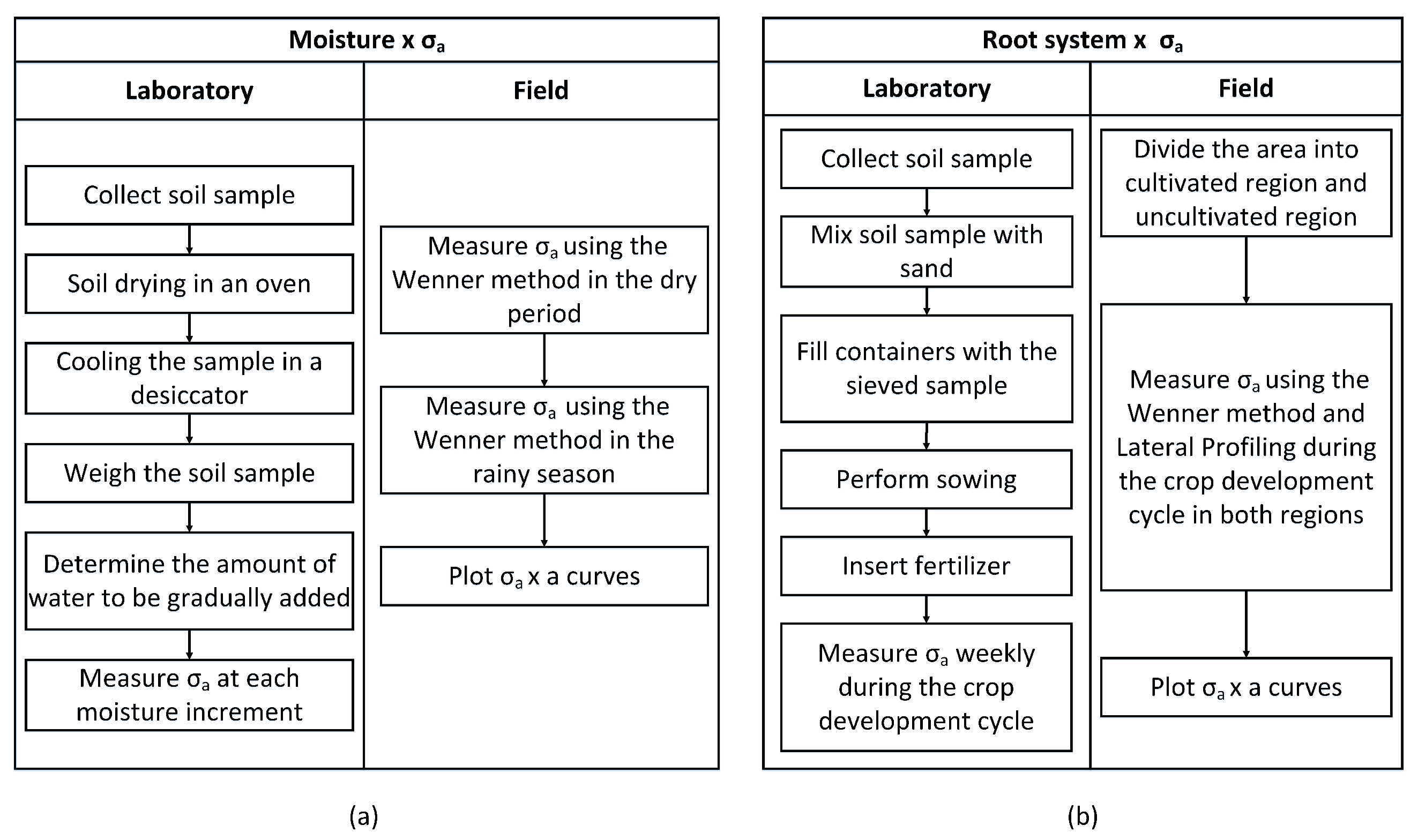


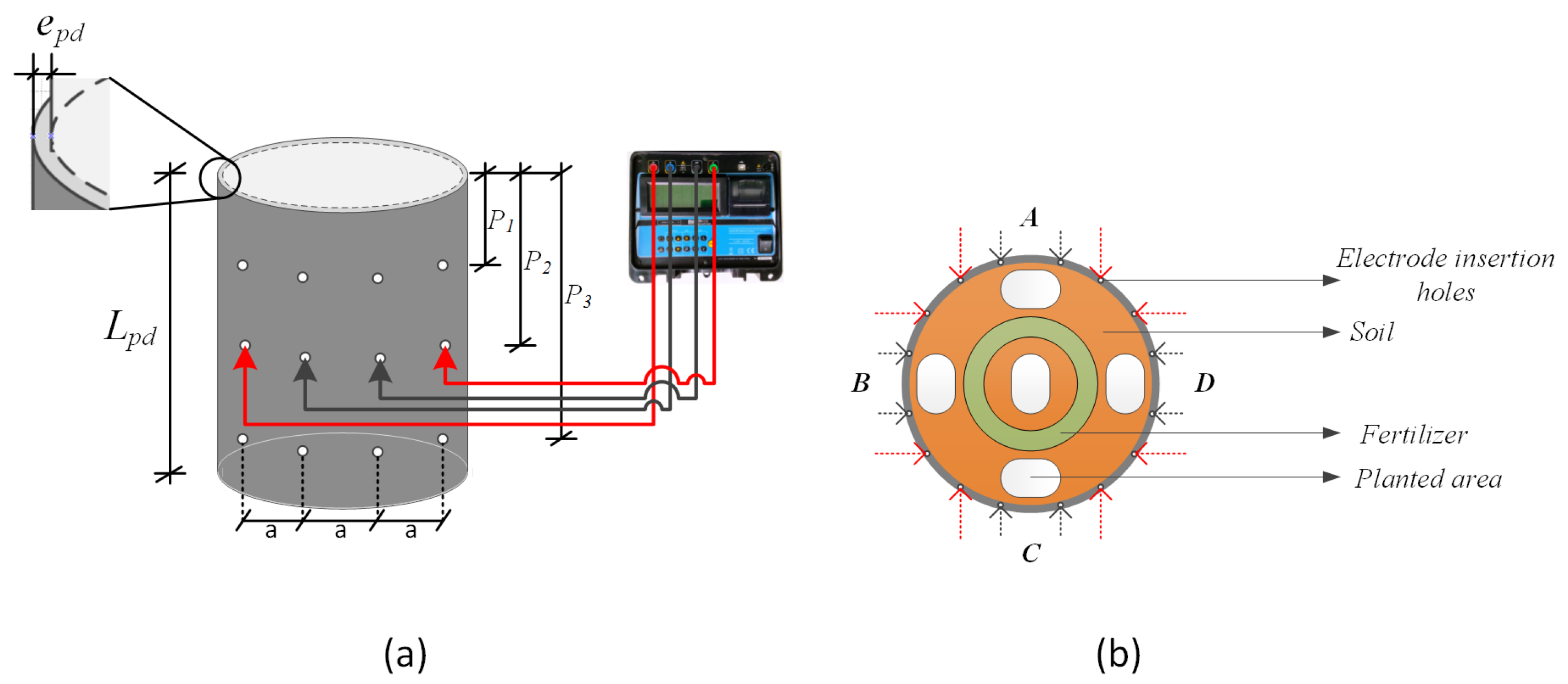
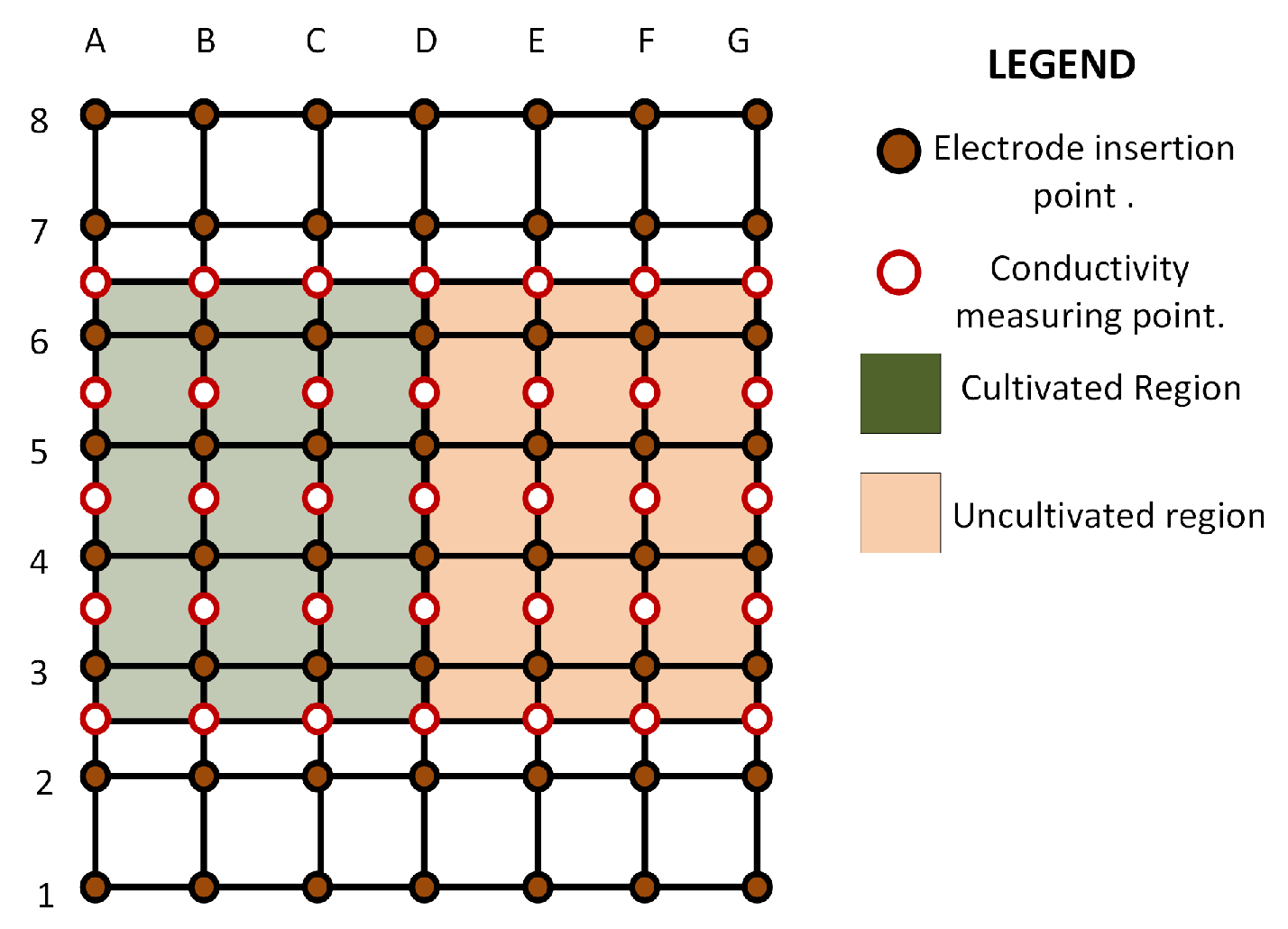
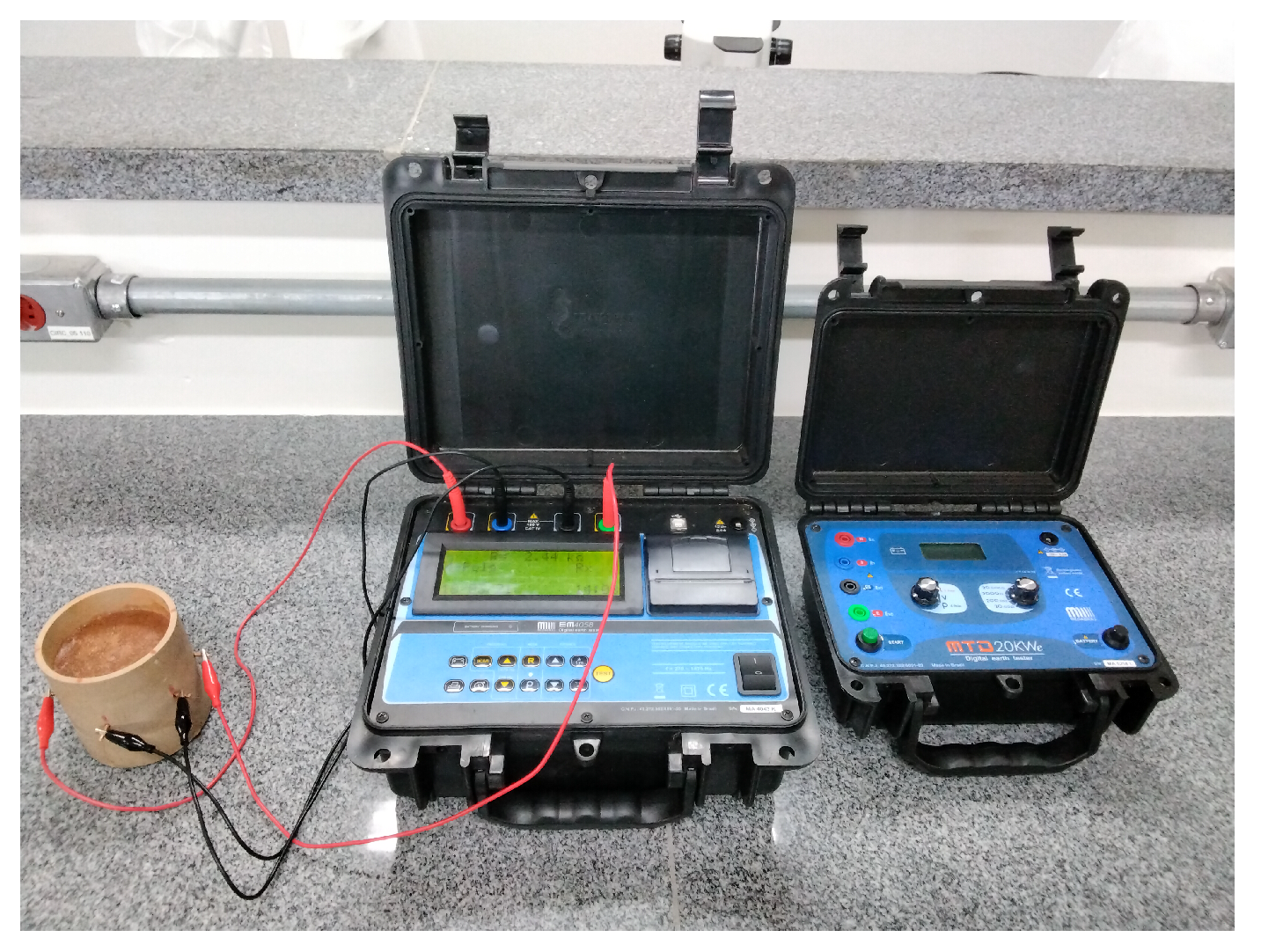
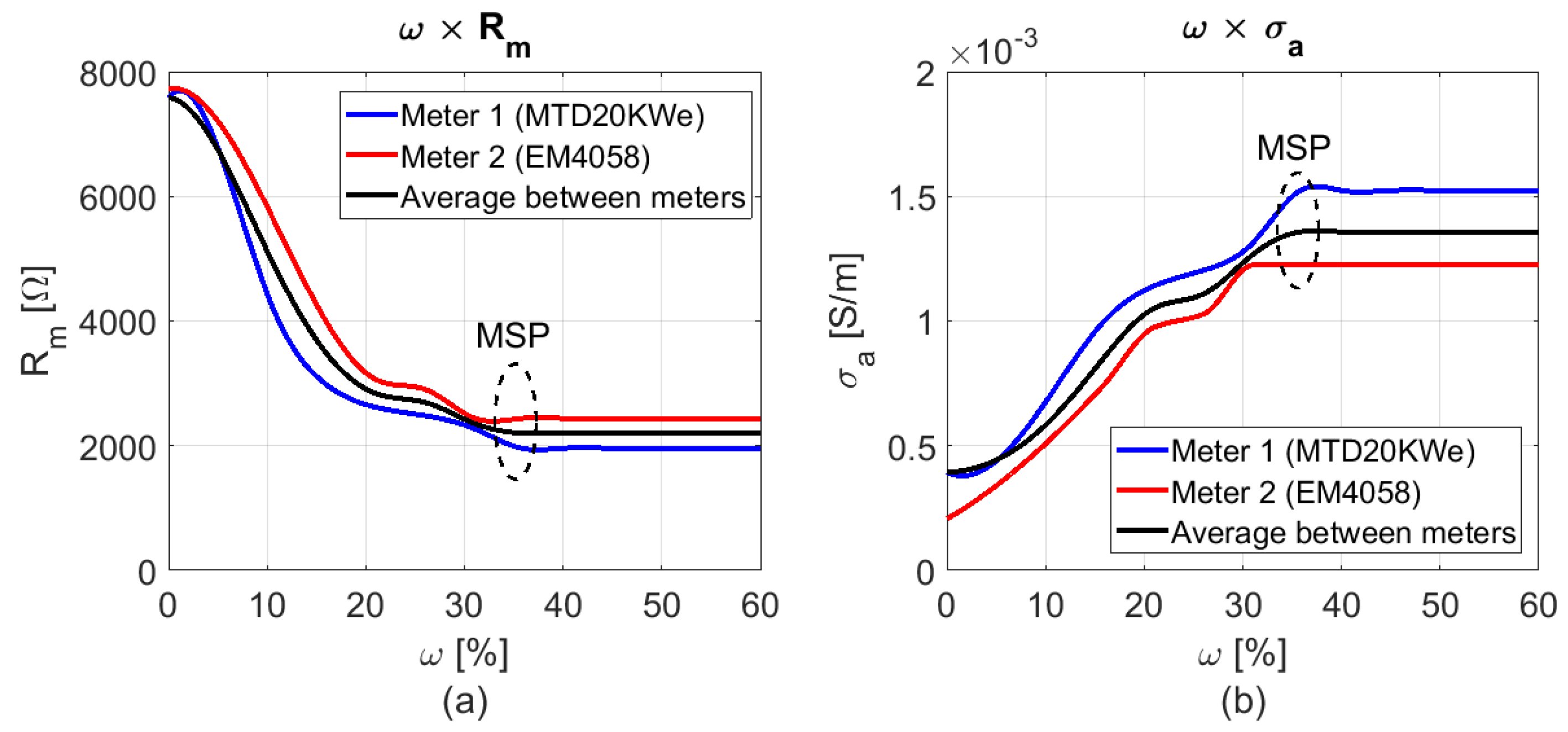

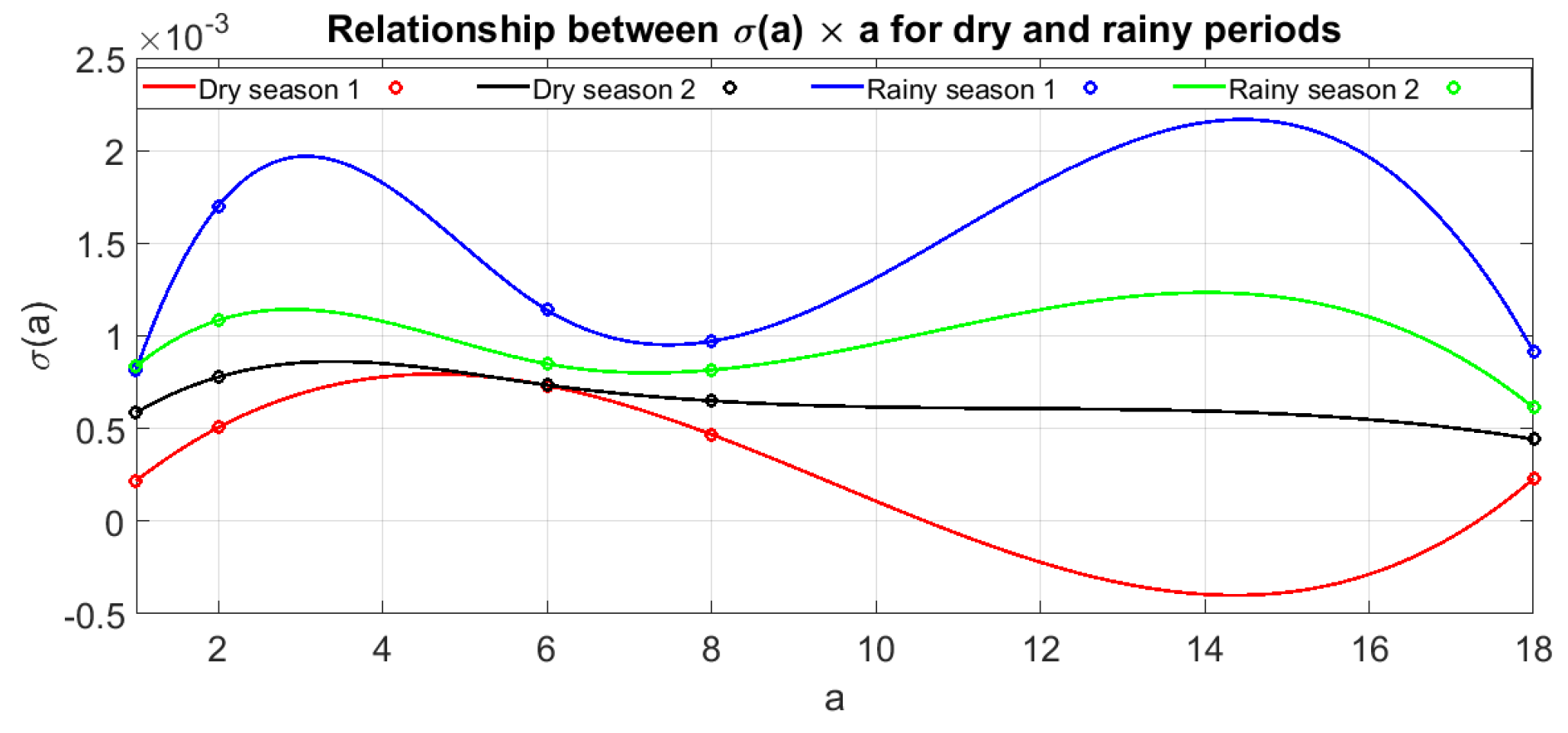

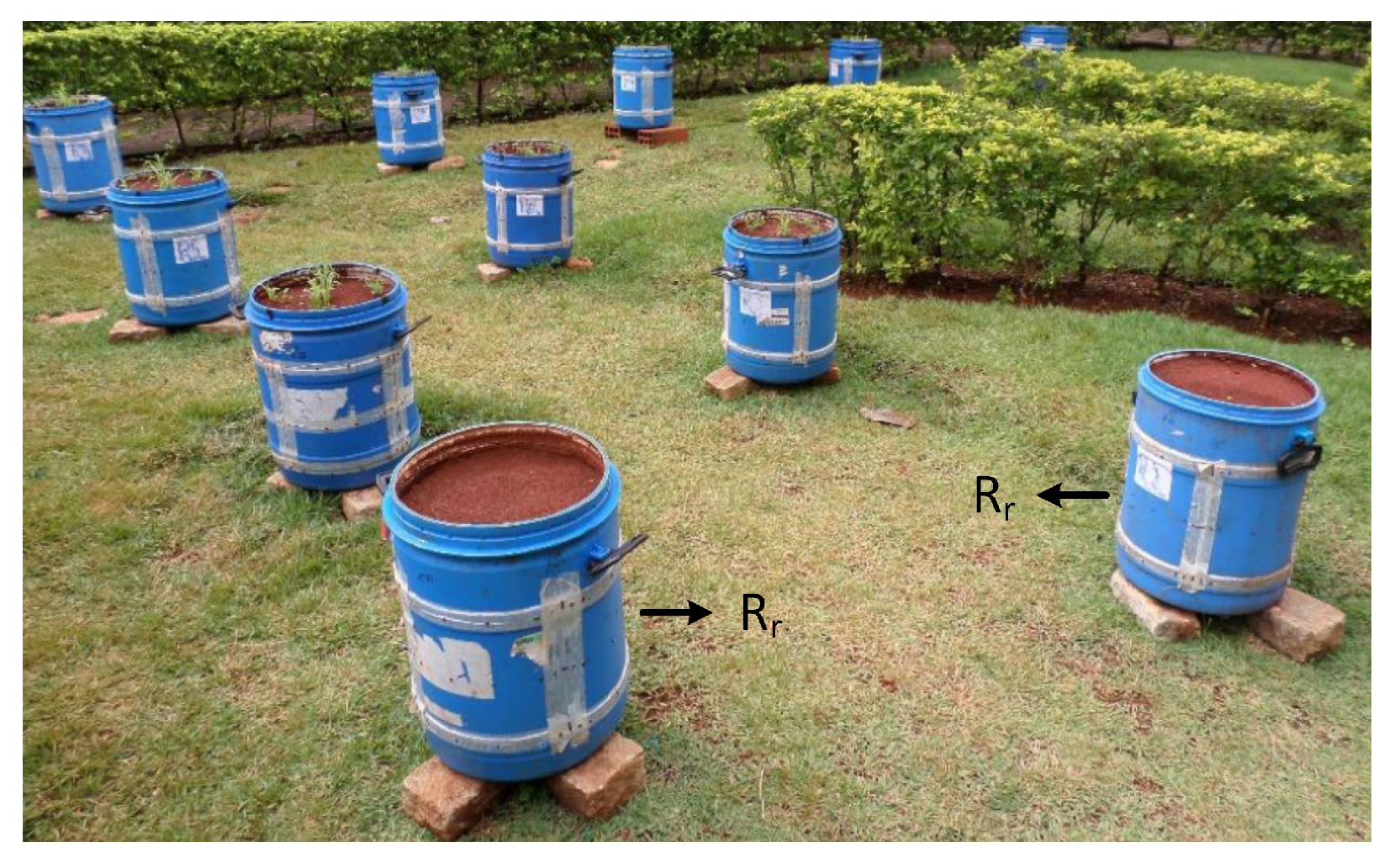



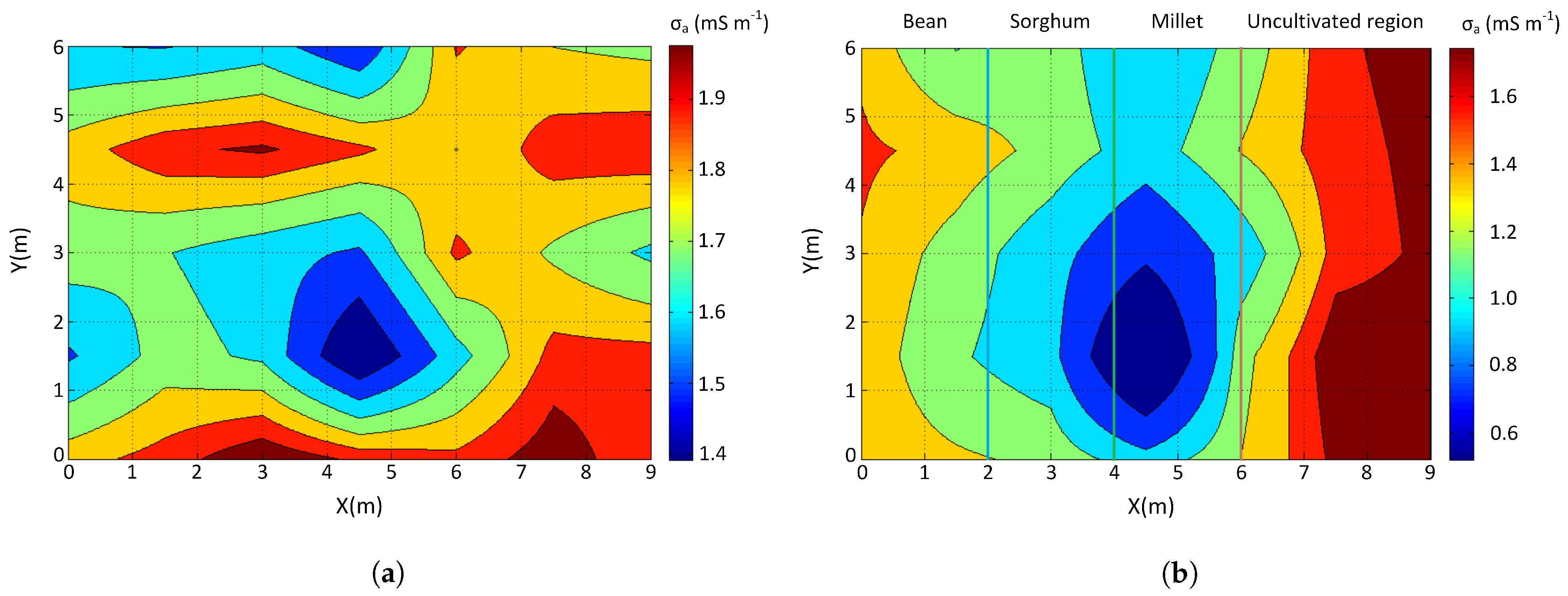
| [] | [ ] | [mm] | |
|---|---|---|---|
| Dryseason 1 | 31 | 21 | 84 |
| Dryseason 2 | 27 | 18 | 89 |
| Rainyseason 1 | 26 | 19 | 225 |
| Rainyseason 2 | 26 | 19 | 171 |
| Thickness [m] | Resistivity [ m] | |||||||
|---|---|---|---|---|---|---|---|---|
| Dryseason 1 | 0.40 | 6.65 | 6.43 | ∞ | 5175.93 | 18,009.90 | 1806.96 | 10,684.20 |
| Rainyseason 1 | 0.37 | 6.51 | 9.82 | ∞ | 5175.93 | 18,173.00 | 1895.75 | 7120.07 |
Publisher’s Note: MDPI stays neutral with regard to jurisdictional claims in published maps and institutional affiliations. |
© 2021 by the authors. Licensee MDPI, Basel, Switzerland. This article is an open access article distributed under the terms and conditions of the Creative Commons Attribution (CC BY) license (https://creativecommons.org/licenses/by/4.0/).
Share and Cite
Silva Filho, A.M.; Silva, J.R.S.; Fernandes, G.M.; Morais, L.D.S.; Coimbra, A.P.; Calixto, W.P. Root System Analysis and Influence of Moisture on Soil Electrical Properties. Energies 2021, 14, 6951. https://doi.org/10.3390/en14216951
Silva Filho AM, Silva JRS, Fernandes GM, Morais LDS, Coimbra AP, Calixto WP. Root System Analysis and Influence of Moisture on Soil Electrical Properties. Energies. 2021; 14(21):6951. https://doi.org/10.3390/en14216951
Chicago/Turabian StyleSilva Filho, Antonio M., José R. S. Silva, Glaciano M. Fernandes, Lucas D. S. Morais, Antonio P. Coimbra, and Wesley P. Calixto. 2021. "Root System Analysis and Influence of Moisture on Soil Electrical Properties" Energies 14, no. 21: 6951. https://doi.org/10.3390/en14216951






